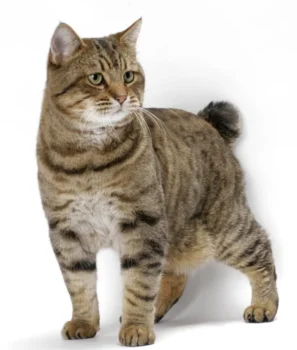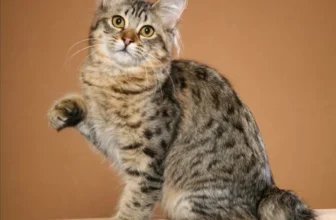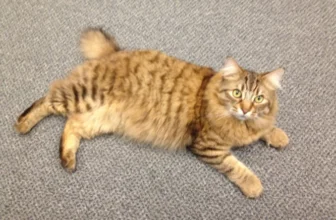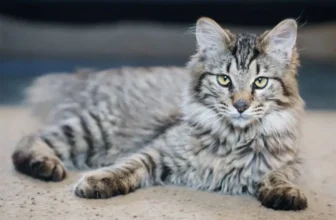As cat enthusiasts, we are mesmerized by the beauty and unique qualities of every feline breed. The American Bobtail cat breed stands out from the crowd with its distinctive bobbed tail, muscular physique, and wild appearance. But have you ever wondered about the origins of this breed and how it came to be? In this comprehensive guide, we will explore the history, physical characteristics, temperament, grooming, and health of the American Bobtail breed. Additionally, we will uncover some interesting facts about this breed, including myths and legends, celebrity pets, and their role as working cats. So, let’s dive into the fascinating world of American Bobtail cats!
The Evolution of American Bobtail Cats
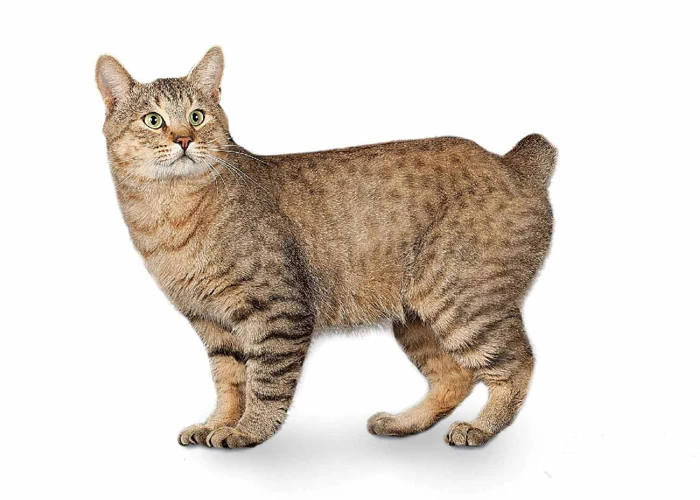
As we marvel at the American Bobtail breed of cats today, it’s natural to wonder how this unique and charming breed came into being. The origins of the American Bobtail can be traced back to early feline ancestors who have evolved over thousands of years to become the lovable cats we know today. Understanding the history of the American Bobtail breed can deepen our appreciation of these fascinating felines. Whether you’re interested in the foundation cats, crossbreeding or environmental factors that influenced the breed’s evolution, we have laid out a comprehensive guide to help you in your quest for knowledge. So, let’s dive into the intriguing world of American Bobtail cats and see how they came to be the wonderful companions they are today. To learn more about the American Bobtail’s ancestor and its impact on the breed standard follow this link.
Foundation Cats
The origins of the American Bobtail breed can be traced back to the late 1960s, when a young couple discovered a short-tailed stray kitten on their doorstep in Arizona. They named the kitten Yodie and quickly fell in love with his unique appearance and friendly demeanor. Yodie became the foundation cat of the American Bobtail breed, and his descendants were soon crossed with other breeds to create the diverse gene pool that exists today.
Siamese and Manx are among the breeds that were used to develop the American Bobtail. These cats were chosen for their distinctive physical characteristics and compatibility with the bobtail gene. The tailless Manx breed, with its sturdy frame and affectionate nature, provided a solid foundation for the American Bobtail. Siamese cats were also added to the mix to impart their striking Siamese-pointed coloration and vocal personalities.
Eventually, other breeds were included in the breeding program to broaden the gene pool and increase genetic diversity. Some of the breeds used in these outcrosses included the Himalayan, the Burmese, and the Abyssinian. This diversity of breeds and traits helped solidify the American Bobtail as a unique breed with its own distinct characteristics.
The process of crossbreeding was a key factor in the development of the American Bobtail breed. The inclusion of different breeds helped to ensure that the breed would have a wide range of physical characteristics, temperaments, and health profiles. This made it much easier to eliminate unwanted traits and select for desirable ones.
It’s important to note that the development of the American Bobtail breed was influenced not only by the selective breeding practices of cat breeders, but also by environmental factors such as climate and geography. Factors such as the arid climate of the American Southwest may have played a role in shaping the breed’s physical characteristics.
Today, the American Bobtail breed continues to evolve and adapt to changing environments and breeding practices. The breed is recognized for its distinctive looks, outgoing personalities, and affectionate nature. If you’d like to learn more about the evolution of cat breeds like the American Bobtail, check out our article on the Manx-American Bobtail Evolution.
Breed Development
The development of the American Bobtail breed is an intriguing story that showcases the perseverance of breeders and the adaptability of cats. With the breed’s foundation starting with a chance meeting of two cats with short tails in the 1960s, the breed’s evolution was jumpstarted with the careful curation of breeding pairs to maintain the unique physical characteristics of the American Bobtail. In fact, the breed is still actively being developed today, with breed enthusiasts constantly working to refine the breed standard.
One of the keys to the successful development of the American Bobtail breed has been strategic crossbreeding. To ensure the continued genetic diversity and health of the breed, breeders have carefully introduced new bloodlines into the breed through the addition of breeds such as the Siamese and the Himalayan. However, it is important to note that these outcrosses must be done with caution, as the American Bobtail’s unique traits must be preserved.
Additionally, the environment and climate of the cats’ early ancestors likely played a role in the development of the breed’s physical characteristics. The breed’s short, thick coat and sturdy body is believed to have been an adaptation to the harsh winters and rugged terrain of North America. This hardy nature has certainly been passed down to the modern American Bobtail, which is known for being a healthy and resilient breed.
The development of the American Bobtail breed is a fascinating tale of innovation and dedication to creating a unique breed with a distinctive look and temperament. To learn more about the breed’s physical characteristics, be sure to check out our article on American Bobtail characteristics.
Recognition
Recognition: The American Bobtail was recognized as an official breed by The International Cat Association in 1989. It is also recognized by the Cat Fanciers’ Association and other smaller cat registries. These organizations recognize Bobtails in a variety of colors and patterns, including tabby, tortoiseshell, calico, and solid colors. They also recognize both long-haired and short-haired American Bobtails.
To be eligible for show, American Bobtail cats must be at least eight months old and have a wild appearance. The breed has also been recognized for its unique personality and is often described as dog-like in its attentiveness to its owners.
Interestingly, the recognition of the breed has sparked debates among cat fanciers about its origin. Some suggest that the breed was established through crossbreeding with a wildcat species, while others believe that the breed was formed through the natural process of genetic mutation. You can read more about the impact of crossbreeding on American Bobtail evolution in our article about crossbreeding and American Bobtail evolution. Additionally, some experts suggest that the environment and climate played a crucial role in the American Bobtail’s evolution. You can read more about this argument in our article about the environment and climate’s impact on American Bobtail evolution.
Despite these debates, American Bobtail cats have gained immense popularity among cat lovers worldwide. Their unique appearance, affectionate nature, and friendly disposition make them excellent pets for families and individuals alike.
American Bobtail Breed Information
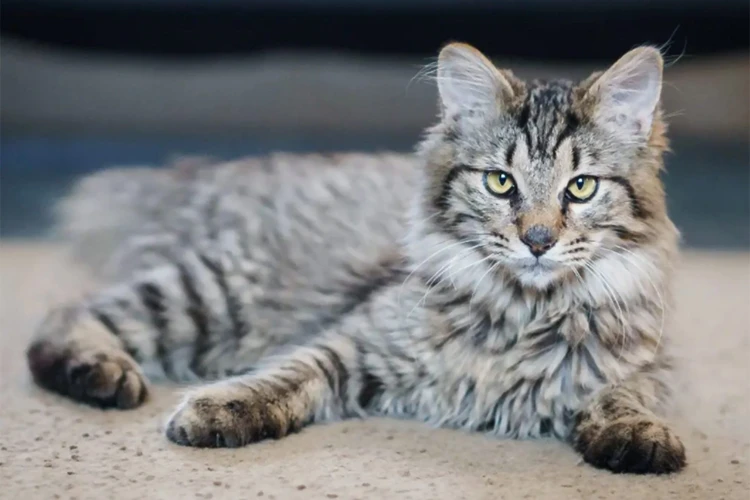
As we dive into the world of American Bobtail cats, it’s important to understand the unique characteristics that make this breed so well-loved. Let’s take a closer look at the physical and temperament traits of the American Bobtail breed, as well as their grooming needs and potential health concerns. Whether you’re a current owner or simply fascinated by these captivating felines, you’ll discover all the key information you need in this section. So, grab a cup of coffee and let’s explore the fascinating world of American Bobtails.
Physical Characteristics
American Bobtail cats are known for their distinctive appearance, which is similar to that of a bobcat. They are a medium to large-sized breed, with well-muscled bodies and broad heads. Here are some of the most notable physical characteristics of American Bobtail cats:
| Characteristic | Description |
|---|---|
| Coat | American Bobtails have a shaggy, semi-longhaired coat that is water-resistant and comes in a variety of colors and patterns. The fur is thick and plush, and a ruff around the neck is often visible, particularly in males. |
| Tail | The most distinct feature of the American Bobtail is its short, stubby tail, which is about one-third to one-half the length of a typical cat’s tail. It can be curved, straight, or slightly kinked, and is covered in thick, shaggy fur. |
| Body | The body of an American Bobtail is muscular and rectangular, with broad shoulders and a deep chest. They have long, powerful legs and large, round paws. |
| Head | American Bobtails have broad, wedge-shaped heads with high cheekbones and a prominent brow ridge. They have large, almond-shaped eyes that are set slightly slanted, and their ears are medium-sized and pointed. |
| Size | Male American Bobtails can weigh up to 16 pounds, while females typically weigh between 7 and 12 pounds. They typically stand about 10 to 13 inches tall at the shoulder, and the length of their bodies ranges from 1 to 2 feet. |
American Bobtails have a sturdy, muscular build and a distinctive, wild appearance that sets them apart from other domestic cat breeds. Their unique physical features make them a popular choice among cat enthusiasts who appreciate their striking appearance and friendly temperament.
Temperament
The American Bobtail’s temperament is one of its most admirable traits. They have a playful, affectionate, and patient nature that makes them excellent family pets.
Playfulness: American Bobtails are highly active cats that love to play. They have a natural hunting instinct and enjoy chasing toys and playing fetch. They are also known to be excellent climbers, so providing them with a tall scratch post or climbing tower is important to keep them entertained.
Affection: Unlike some cat breeds that can be aloof, the American Bobtail loves to be around people. They are affectionate and enjoy being petted and cuddled. They are also known to follow their humans around the house and greet them at the door.
Patience: The American Bobtail is a patient cat that is great for families with children. They can tolerate being handled and played with without getting aggressive or defensive. They are also great with other pets and can live harmoniously with dogs and other cats.
The American Bobtail’s temperament makes it an ideal family pet that is both playful and affectionate. They thrive in a household where they receive plenty of attention and love.
| Temperament | Description |
|---|---|
| Playfulness | American Bobtails love to play and have a natural hunting instinct. |
| Affection | American Bobtails are affectionate and enjoy being petted and cuddled. |
| Patience | American Bobtails are patient cats that can tolerate being handled and played with. |
Grooming
American Bobtails require minimal grooming, making them a low-maintenance breed. Their fur is thick and luscious, which provides natural protection from both hot and cold temperatures. Here are some tips on how to keep your American Bobtail’s coat healthy and shiny:
| Grooming Tip | Explanation |
|---|---|
| Weekly Brushing | Brushing your American Bobtail once a week with a slicker brush or comb will help remove loose furs and prevent matting. |
| Bathing | American Bobtails seldom need baths. It is best to bathe them only when necessary and use a good quality, gentle shampoo to keep their coat healthy. |
| Trimming Nails | Trimming the nails of your American Bobtail is essential to prevent them from becoming too long and causing discomfort. It is recommended to trim their nails once a month. |
| Cleaning Ears | Regular ear cleaning can help to remove any build-up of wax or debris. Use a cotton ball soaked in warm water or a gentle ear-cleaning solution. |
| Regular Vet Check-Ups | It is essential to take your American Bobtail to the vet for regular check-ups. The vet can examine your cat’s coat, skin, and overall health, which will help to detect any potential health issues early. |
Note that over-grooming can damage the natural oils present in the cat’s coat, leading to dryness and breakage. It’s important to make sure not to brush or bathe your American Bobtail too frequently, as it can lead to skin irritation or discomfort. American Bobtails are a healthy breed, but regular grooming and care will help to maintain their natural beauty and longevity.
Health
One of the biggest advantages of the American Bobtail cat breed is that they have relatively few health problems. However, there are still a few issues that potential owners should be aware of when it comes to the health of these cats. Here are some of the most common health concerns for American Bobtails:
| Health Concern | Symptoms | Treatment |
|---|---|---|
| Feline Lower Urinary Tract Disease (FLUTD) | Difficulty urinating, frequent urination, blood in urine | Medications, change in diet, increased water intake |
| Hypertrophic Cardiomyopathy (HCM) | Heart murmur, difficulty breathing, exercise intolerance | Medications to manage symptoms, surgery in severe cases |
| Obesity | Excessive weight gain, lethargy, joint pain | Dietary changes, increased exercise |
| Periodontal Disease | Bad breath, inflamed gums, missing teeth | Professional dental cleaning, regular brushing |
It’s important to note that not all American Bobtails will develop these health problems, and in many cases, they can be prevented with proper care and attention. Regular visits to the vet and a healthy diet and exercise routine can go a long way in keeping your American Bobtail happy and healthy. As with any pet, it’s important to do your research and be aware of the potential health concerns before bringing an American Bobtail into your home.
Interesting Facts About American Bobtail Cats
As unique as their appearance, American Bobtail cats have a fascinating history and many intriguing characteristics. From myths and legends to famous feline celebrities, these cats have captured the hearts of animal lovers worldwide. So, let’s dive into some captivating and lesser-known facts about the American Bobtail breed.
Myths and Legends
Throughout history, several myths and legends have surrounded the American Bobtail breed, making them an intriguing subject for cat lovers. Below are some of the most popular myths and legends related to American Bobtail cats:
| Myth/Legend | Description |
|---|---|
| The Bobtail’s Tail was Cut | One myth surrounding this breed is that their tails were cut short because farmers believed it would help them move quicker and avoid getting caught in their equipment. However, this is not true. The American Bobtail breed was not created artificially, and their tails have always been naturally short. |
| Bobtails are Descendants of Wild Lynx | Some people believe that the American Bobtail breed has wild lynx in their ancestry. Although they do resemble Lynx, there is no evidence to support this claim, and it is likely that they are not descendants of wild Lynx. |
| Bobtails Bring Good Luck | There is a legend that American Bobtail cats bring good luck to their owners. In some cultures, they are considered a symbol of wealth and prosperity. While there is no scientific evidence to support this claim, many owners of American Bobtails feel lucky to have them in their lives. |
| Bobtails are Protected by the Government | There is a myth that the American government protects the American Bobtail breed and has passed laws to guarantee their preservation. While the breed is highly valued and recognized by several cat associations, there is no law protecting American Bobtails specifically. |
It is important to note that these myths and legends are not based on scientific facts, but they contribute to the breed’s unique and fascinating history. Despite these unproven stories, the American Bobtail remains a cherished and beloved breed for many cat lovers.
Celebrity Pets
It’s not uncommon for celebrities to adore pets, and American Bobtail cats are no exception to their affections. In fact, the breed has been featured in various movies and TV shows, making them an instant hit among cat lovers.
Some celebrities who are known to have owned or still own American Bobtail cats include:
| Celebrity | American Bobtail Cat | Instagram Handle |
|---|---|---|
| Justin Bieber | Esther | @estherthecat |
| Halsey | Jubilee | @iamhalsey |
| Kit Harington | Bob | N/A |
| Khloe Kardashian | Gabbana | N/A |
Justin Bieber is a famous pop star who is often seen with his beloved American Bobtail cat, Esther. He frequently shares photos of Esther on his social media account, which has helped raise awareness about the breed among his millions of followers.
Halsey, another celebrity who has an American Bobtail cat, also shares photos of her feline friend, Jubilee, on social media. She often writes about how much she loves her cat and how it has helped her with her anxiety.
Game of Thrones star Kit Harington is another celebrity who is known to own an American Bobtail cat. He has even shared in interviews how his cat, Bob, helps him relax after a long day of shooting.
Khloe Kardashian is also a proud owner of an American Bobtail cat named Gabbana. While she doesn’t share many photos of her cat on social media, she has mentioned Gabbana in interviews and has expressed her love for her furry friend.
It’s clear that American Bobtail cats have found their way into the hearts of many celebrities. Their unique appearance and playful personalities make them a charming addition to any household.
Working Cats
American Bobtail cats have been known to excel in various roles, including being great hunters and reliable working cats. These felines have a strong hunting instinct, making them great at keeping homes and farms free of rodents and pests.
In fact, American Bobtails have been known to be used as working cats in various settings such as warehouses, factories, and shops. They possess excellent problem-solving skills, and their curious nature often leads them to investigate their surroundings, making them even more suitable for the task.
One interesting example of American Bobtail working cats can be found in a brewery in Vermont. The brewery hired two American Bobtails named Sybil and Stash to catch any mice and rats that might be attracted to the grain and hops. Such actions are not uncommon, as many breweries and distilleries prefer to use cats for rodent control instead of harmful pesticides.
Another example of American Bobtails being useful working cats is in libraries around the world. Libraries, particularly those with old and rare books, are prone to pest infestations. To avoid using chemicals that could damage the books, libraries have been known to use cats to keep the pests at bay. One such library is the White Settlement Public Library in Texas, which has a resident American Bobtail named Browser. Browser became a beloved celebrity at the library and even has his own library card.
It’s remarkable to see how American Bobtail cats, with their natural abilities and intelligence, have become a valuable asset in different work environments. They not only bring joy and companionship to their owners but also fulfill an essential role in keeping these places pest-free.
Conclusion
After researching and writing this comprehensive guide to the origins and characteristics of the American Bobtail breed, it’s clear that they’re a fascinating and beloved feline variety. From their rugged, wild appearance to their playful and social disposition, American Bobtails make excellent pets for a variety of households.
One of the most interesting things about the breed is their unique fur patterns and textures. With a shaggy coat and a variety of colors and patterns, no two American Bobtails look exactly the same. Additionally, their distinctive bobbed tails not only make them stand out from other cat breeds, but also add to their overall charm and character.
Despite having a wild and independent appearance, it’s important to note that American Bobtails are also known for their friendly and playful temperaments. They are social animals who enjoy interacting with both other cats and humans, making them ideal pets for families or anyone searching for a companion.
As with any cat breed, it’s important for potential owners to be aware of the breed-specific health concerns that American Bobtails can be prone to. However, with proper care and veterinary attention, they can live long and healthy lives.
Overall, the American Bobtail breed is a unique and remarkable feline variety that continues to captivate cat lovers around the world. Whether you’re drawn to their wild appearance or their friendly personalities, the American Bobtail breed is definitely worth considering as your next feline companion.
Frequently Asked Questions
What is the origin of American Bobtail Cats?
The American Bobtail breed originated in the 1960s in Arizona, USA, when a short-tailed tabby cat was crossed with a Siamese cat. This created the breed’s unique physical characteristics.
What do American Bobtails look like?
American Bobtails are medium to large cats with a muscular build, fluffy coats, and short tails that are often curved, kinked, or slightly bobbed. They can come in a variety of coat colors and patterns.
What is the temperament of American Bobtails?
American Bobtails are known for being intelligent, affectionate, and playful cats. They have a reputation for being good with children and other pets, and they are often described as being dog-like in their behavior.
Do American Bobtails require a lot of grooming?
American Bobtails have a dense, fluffy coat that requires regular brushing to prevent matting and tangles. However, they do not require the same level of grooming as some long-haired breeds.
What health issues are common in American Bobtails?
Like all cats, American Bobtails can be prone to certain health issues, such as hip dysplasia and hypertrophic cardiomyopathy. However, with regular vet checkups and proper care, these issues can often be managed.
Can American Bobtails be trained?
American Bobtails are highly intelligent cats that can be trained to do a variety of tricks and behaviors, such as walking on a leash or playing fetch.
Are American Bobtails hypoallergenic?
No cat breed is completely hypoallergenic, but some people with allergies may find that they have less of a reaction to American Bobtails than to other breeds.
What famous people own American Bobtails?
Famous American Bobtail owners include author Stephen King and actress Nicole Kidman.
Can American Bobtails be used as therapy cats?
American Bobtails have a friendly, affectionate demeanor that makes them well-suited to being therapy cats. They have been used in a variety of settings, including hospitals and nursing homes.
Are American Bobtails good hunters?
American Bobtails have a strong hunting instinct and are skilled at catching rodents and other small prey. However, they are also affectionate and make great indoor pets, so it’s important to provide them with plenty of toys and playtime to satisfy their hunting drive.

